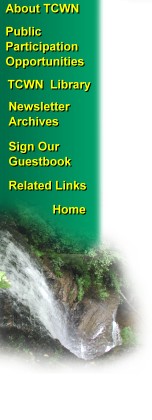 |
 |
|
Below Kentucky Dam, I slog the last 22 miles of the Tennessee
as Jasper urges me on. Photo: Jim Roshan
|
When I tell serious canoeists that I paddled the length of the
Tennessee, they look at me as if I've lost my mind. It is not a
river that is frequently paddled, even for short stretches. In fact,
over the course of the entire 652 miles-from Knoxville to Paducah,
Kentucky-I saw only three canoeists. One reason is obvious: most
canoeists like moving water, and the Tennessee, though once a wild
and raging stream, does not move, at least not on its own. The Tennessee
Valley Authority's dams transformed the unpredictible river into
a string of nine placid reservoirs designed for power generation,
flood control, and commercial navigation. For a paddler this means
work, and for most, monotony.
|
I had my reasons for such a long, grueling voyage on
a river turbulent with the wakes of cabin cruisers, jet skis, and towboats.
First, I had a personal connection with the Tennessee, having grown up in
Murray, Kentucky, just a few miles from Kentucky Lake (the lower Tennessee),
where I spent much of my first 25 years fishing and boating. Now I live
near Knoxville, just a short drive from the river's source, at the junction
of the Holston and the French Broad. I wanted to see how the winding channel
and bluffs of the upper river would be transformed into the vast hazy distances
of Kentucky Lake, and I wanted to see it from the cane-bottomed seat of
my canoe so that I could be close enough to the water to smell it, to dip
my hand in it and cool myself off. I wanted to write about the river from
a unique perspective, and though I knew I could never feel what the Cherokee
felt as they paddled their dugouts, never know the thrills and fears of
the first white men in their flatboats, I wanted to get as close to that
feeling as possible, and propelling myself without the noise and stink of
a motor was the best way to do that.
|
My only companion was my dog, Jasper, though my
wife, Julie, a veterinarian, met us at three points along the river
for logistical and emotional support, general morale boosting, and
medical checkups. When we launched on the Holston at the end of August
1998, Jasper had no idea we'd be gone for five weeks, away from air
conditioning and his big pillow bed. Though he wanted to explore the
bank more often than I did and tended to bark at people I was interviewing,
Jasper was ideal for such a voyage, big enough to bluff troublemakers
and friendly enough to win me sympathy (and sometimes food).
|
Jasper and I camped near the cooling towers of Watts Bar Nuclear
Plant, near Watts Bar Dam.
|
Even though it has been transformed from a moving column
of water to a string of lakes, the Tennessee is still a beautiful river,
with much to recommend to a canoeist, much to preserve and protect. There
are the dramatic bluffs of Nickajack Lake below Chattanooga, the islands
of Watts Bar, and vast blue Kentucky Lake, dotted with the colorful sails
of regattas. There is also much that is not so beautiful. We camped downriver
of Colbert Ferry Steam Plant, below Florence, Alabama, where the water had
a peculiar smell and was warm as bath water from the plant's discharge.
Near the mouth of the Tennessee-Tombigbee Waterway, on Pickwick Lake, we
came upon a slick of oil or gasoline, left behind by a leaking barge. For
almost a mile we choked on the fumes. Many shorelines where we camped were
littered with the usual garbage: bottles, cigarette butts, plastic wrappers
and containers, even dirty diapers. Hundreds of times during the trip, we
had to turn our bow to climb the four-foot wakes of cabin cruisers in order
to stay afloat with our five weeks of provisions. When these wakes crashed
against the shoreline, chunks of the bank fell into the river, further clouding
the already turbid water. Before my canoe trip, I interviewed a man named
Charley Dickey who rowed the river in a homemade dory in 1937. He drank
untreated river water the whole way, and did not get sick. Now, it probably
wouldn't take much to make you sick.
We won't have the old, free-flowing Tennessee back any time soon; the
dams are here for the forseeable future. What we can do is minimize our
impact on an overworked river. Smaller motors, less industrial and residential
development, more flow through the dams are just a few things that would
help revive a troubled river. Someday, I'd like it if when I mentioned
having canoed the Tennessee, paddlers wouldn't shake their heads and grimace,
but instead would want to try it themselves.
|
|
Kim Trevathan's book, Paddling the Tennessee
River: A Voyage on Easy Water, will be published by the University
of Tennessee Press in October as part of the Outdoor Tennessee
Series.
|
|


